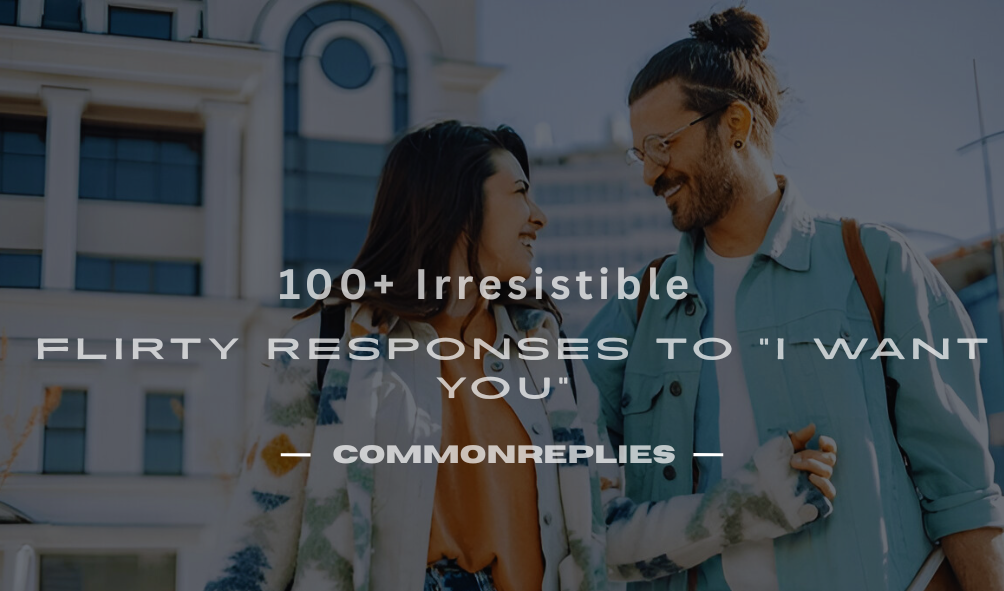Flirting is an art that can either make a moment unforgettable or awkward. If you’re looking to keep things light, playful, and exciting, knowing the right flirty responses is key.
One of the most common phrases you might encounter in a flirtatious exchange is “I want you.” But how do you respond without sounding too eager or too distant?
Let’s dive into some fun and sassy replies that will leave the other person intrigued and wanting more!
The Power of Playful Banter
Flirty banter can create a fun and lighthearted atmosphere that draws people closer. The key is to keep things playful and avoid crossing any boundaries. Here are some playful responses that can add energy to the conversation:
- Flirting is like dancing—it’s all about rhythm. Keep it light, fun, and spontaneous.
- A quick joke about how great you are can bring out the best in both of you.
- Let your humor show. People love someone who can make them laugh and not take themselves too seriously.
- Play with words and tease a little—nothing too serious, just enough to keep the other person intrigued.
- A playful tease about something they said earlier can spark an amusing exchange.
- If you can make someone smile with your wit, it’s already a win.
- Keep your responses witty but avoid being overly sarcastic or cynical.
- Sometimes, a cute, random comment that comes out of nowhere is exactly the playful banter needed to break the ice.
- Don’t be afraid to laugh at yourself. Self-deprecating humor adds charm.
- A flirty comment about the situation you’re in can make for an amusing and light-hearted interaction.
Understanding Flirting Dynamics
- Flirting is an intricate dance where both parties are testing boundaries and signaling attraction. Knowing the dynamics can make all the difference in how your flirting is received.
- Flirting isn’t just about the words—it’s about how you make the other person feel.
- Being observant is key. Notice their body language and tone, as they’ll help guide your responses.
- Flirting should feel effortless, not forced. The best moments come from genuine interest, not rehearsed lines.
- Keep it playful but respectful. Boundaries are important, and understanding the other person’s comfort zone can prevent awkwardness.
- The way you interact with someone shows them how much attention you’re paying to them. Flirting is about showing that interest in subtle ways.
- Flirting should be a mutual exchange, not one-sided. Pay attention to how they respond to keep the balance.
- Always ensure your flirtation feels natural to you—don’t try to be someone you’re not.
- Sometimes, less is more. A few well-timed words can have a bigger impact than a lengthy flirty monologue.
- Flirting can be empowering when done right. It’s about expressing attraction in a way that boosts confidence.
- Understanding the other person’s reactions is crucial. Whether they mirror your playfulness or not, it’s a sign you’re on the right track.
Top 10 Flirty Responses to I Want You
When someone says they want you, it can be the perfect moment to show off your playful side. Here are some responses that will keep the mood fun and exciting:
- I’m flattered. But are you sure you can handle me?
- Well, you know what they say—be careful what you wish for.
- Are you sure you can keep up?
- Do you really want me, or are you just trying to get under my skin?
- That’s an offer I might just accept.
- Is that so? What makes you think you can handle all this?
- I’d love to hear more about what you want, but I’m curious what you’re willing to give in return.
- Well, lucky for you, I’m not one to turn down a good challenge.
- Sure, but you’ll have to work for it.
- You’ll have to prove it to me first.
When to Use Flirty Responses
Knowing when to use flirty responses is just as important as knowing what to say. Timing can make or break a playful exchange. Here’s when to deploy those flirty remarks:
- When the conversation is flowing and there’s a comfortable rapport.
- When you sense mutual attraction, and the vibes are right.
- When you want to keep the mood light and fun without getting too serious.
- During moments of playful teasing when both parties are enjoying themselves.
- When they drop a compliment or show interest, it’s the perfect time to flirt back.
- When you’re both in a relaxed, private setting where you can be more daring with your responses.
- When you want to turn a casual exchange into something more exciting.
- If you’ve established a friendly connection, flirting can make things a little more interesting.
- During moments of eye contact or playful gestures where the chemistry is obvious.
- When they’re being cheeky, it’s your cue to return the favor with a flirty reply.
How to Gauge the Right Timing for Flirty Responses
The art of flirting isn’t just about what you say; it’s about knowing when to say it. Here’s how to gauge the timing of your responses:
- Pay attention to their body language. If they’re leaning in or making prolonged eye contact, it’s a good time to drop a flirty comment.
- If the conversation has lightened up, that’s the ideal moment to add some playful remarks.
- Notice if they’re smiling or laughing more—it’s a sign they’re enjoying the banter.
- Gauge their interest by how engaged they are in the conversation. If they’re reciprocating with similar playful responses, it’s time to flirt.
- If they make a suggestive remark, it’s the perfect opportunity to respond in a flirty and playful way.
- When they initiate physical contact or seem comfortable in your presence, that’s the signal to dial up the flirtation.
- If the mood feels relaxed and fun, it’s easy to drop a flirty comment without it feeling forced.
- When they’re giving you compliments, it’s a sign they’re open to receiving flirty remarks in return.
- When the conversation starts to dwindle and you want to inject some energy back into it, a well-placed flirt can reignite the spark.
- When you feel confident and relaxed, that’s when your flirty comments will come across as smooth and natural.

Mastering the Art of Confidence in Flirting
- Confidence is key, so respond with a wink and a smile to show you’re comfortable and playful.
- Keep your posture open and relaxed, maintaining eye contact to exude confidence while delivering your flirty response.
- Try to be bold without overthinking. A confident, casual response can go a long way in keeping the conversation lighthearted.
- When you’re sure of yourself, let your charm shine. Saying something like, I can tell you’re good at making requests, but I’m not so easily persuaded can be a confident response that keeps things fun.
- Confidence is not about arrogance. It’s about owning your playful side and not being afraid to engage in a little banter.
- Playfully challenge them. What makes you think I’ll say yes? This keeps the conversation going with a touch of playful mystery.
- Let your humor shine through. Confidence in flirting can be about being comfortable enough to joke around.
- A gentle touch on the arm or a playful nudge can show confidence and interest without words.
- A slight tilt of the head or a teasing smirk can say everything you need to say when flirting confidently.
- Let them know you are enjoying their company. Saying something like, You certainly know how to make an impression, expresses both confidence and interest.
How Body Language Enhances Flirty Responses
- Leaning slightly toward them while speaking shows interest and engagement.
- A soft touch on the shoulder or arm can add warmth and connection to your response.
- Play with your hair or make light, playful gestures to keep the energy fun and flirty.
- Use open, inviting body language—avoid crossing your arms to seem more approachable.
- Maintaining eye contact, especially with a subtle smile, can communicate attraction without saying a word.
- Mirror their movements or gestures subtly to create a deeper connection and enhance flirtation.
- A little playful dance or movement when responding can make the interaction light-hearted and memorable.
- Subtle body touches, like brushing against them lightly, can elevate the flirty vibe without being too forward.
- A raised eyebrow or a playful tilt of the head can add an intriguing element to your response.
- Body language can say everything—sometimes a glance followed by a wink is all you need for a flirty response.
The Impact of Tone in Flirting
- A playful, lighthearted tone can make even the simplest response sound fun and flirty.
- A soft, sultry tone can add mystery and excitement, making your words linger in their mind.
- The speed of your speech can affect how flirty you come across—slow it down for a more deliberate, seductive response.
- Using a higher pitch when you’re joking around can add a playful and youthful feel to your response.
- A low, steady tone can signal calm confidence, making your response more intriguing and seductive.
- Letting your voice trail off at the end of a sentence can make your flirty response sound more inviting.
- A gentle laugh can soften your words and make your flirtation feel natural and friendly.
- A teasing tone, paired with a playful smile, helps communicate your interest without being too direct.
- A questioning tone, paired with a playful challenge, invites the other person to step up their flirting game.
- The warmth in your voice can enhance the feeling of attraction, making the interaction feel more intimate.
Psychological Aspects of Flirting
- Flirting can be a complex mix of psychological signals and subtle cues. Here are some insightful replies that delve into the deeper psychology of flirting:
- Flirting is a way of signaling interest without being too forward or direct. It often relies on body language and eye contact to communicate feelings.
- When flirting, people sometimes engage in playful teasing as a way to show attraction, while testing the waters to see how the other person responds.
- It’s important to understand that flirting can make people feel more confident or powerful, as it plays into the social dynamics of attraction and validation.
- Psychologically, flirtation can create a sense of excitement, making both individuals feel seen and desired, even if nothing romantic comes out of it.
- Flirting helps to build emotional connection, allowing people to feel like they are understood or admired without immediately diving into a deeper conversation.
- In some cases, flirting can act as a form of stress relief or self-esteem boost, especially when someone is looking for reassurance about their attractiveness.
- When a person flirts, they may unconsciously mimic the body language of the one they’re attracted to, signaling a sense of similarity and bond.
- Flirting can be a form of non-verbal communication, which allows individuals to share interest without the risk of being rejected outright.
- The psychological aspect of flirting can often be linked to the concept of power dynamics, where one person might playfully assert control in the interaction.
- Flirting can also trigger the release of dopamine, the “feel-good” hormone, which makes the process enjoyable and reinforces the behavior.
Flirting Dos and Don’ts
- Knowing the right way to flirt is key to making a lasting impression. Here are some important dos and don’ts:
- Do maintain eye contact, as it can show confidence and establish a deeper connection with someone.
- Don’t invade someone’s personal space. Always respect boundaries and keep the interaction comfortable for both parties.
- Do compliment their appearance or personality, but make sure it’s genuine. Authenticity goes a long way.
- Don’t overdo it with compliments. Excessive flattery can come off as insincere or even uncomfortable.
- Do smile often and stay relaxed. A friendly, approachable demeanor makes flirting feel effortless and enjoyable.
- Don’t use inappropriate or offensive language. Keep it light-hearted and respectful to avoid crossing boundaries.
- Do listen actively when the other person talks. Showing genuine interest will make the conversation flow more smoothly.
- Don’t interrupt or talk over the other person. Flirting is about creating a connection, not dominating the conversation.
- Do give subtle hints about your attraction, such as playful teasing or light touches, but always gauge the other person’s response.
- Don’t be too forward or aggressive. Allow the other person to reciprocate at their own pace.
Flirting in Different Relationship Stages
- Flirting can evolve in different ways depending on the relationship stage. Here are some examples of how flirting changes over time:
- Early stages of dating: Flirting is often fun and lighthearted, meant to build initial attraction and test mutual interest.
- Once you’re more comfortable: Flirting becomes more playful and intimate, with hints of deeper emotional connection.
- After you’ve been together for a while: Flirting can take on a more comforting tone, as it fosters closeness and keeps the relationship exciting.
- When a relationship starts to feel routine: Flirting can help break the monotony and reignite the spark between partners.
- In a long-term relationship: Flirting remains an important tool for maintaining intimacy and emotional connection.
- During an argument: Flirting might be used to lighten the mood, showing affection even when discussing something serious.
- When you’re trying to win someone over: Flirting will likely be more intense and direct as you seek to build interest.
- As you move into exclusivity: Flirting becomes a way of reaffirming your attraction and emotional bond.
- In established relationships: Flirting may be less about physical attraction and more about expressing affection in subtle, non-verbal ways.
- During a rough patch: Flirting can be a way of reconnecting emotionally, bringing back the spark that might have faded.
How to Be Subtle While Being Flirty
- Being subtle while flirting can help you avoid overwhelming the other person. Here are some tips to keep it light:
- Give compliments in moderation, focusing on something specific about the person, such as their sense of humor or intelligence, rather than just their looks.
- Engage in light teasing or playful banter that shows you are interested, but don’t go too far—make sure it feels fun, not hurtful.
- Smile often and maintain friendly body language to signal interest without being overly obvious.
- Use your voice to express warmth and charm, but avoid sounding overly seductive—keep it light and fun.
- Incorporate touch in a subtle, non-intrusive way, like a light tap on the arm or brushing past them, to show closeness without being aggressive.
- Stay present in the conversation, asking questions that show you care, but don’t force a personal connection too soon.
- Show a sense of humor and be playful, but don’t try too hard—flirting should feel natural and effortless.
- Maintain eye contact, but don’t stare. This small act of connection can be incredibly flirty without saying a word.
- Give the other person space to reciprocate, allowing the flirting to develop naturally over time without pushing for an immediate response.
- Be mindful of their cues and adjust your flirting style to match their level of comfort. Subtlety often comes from recognizing and respecting boundaries.
The Role of Mystery in Flirting
- Mystery adds an exciting element to flirting, making it more intriguing. Here’s how to incorporate it into your interactions:
- Don’t reveal everything about yourself right away—let the person be curious and ask questions to get to know you more.
- Maintain some element of surprise by keeping some things private or giving hints about your life instead of full details.
- Create a sense of intrigue by leaving some questions unanswered, encouraging the other person to want to learn more.
- Be unpredictable in your interactions. A little bit of inconsistency in your behavior can keep the other person guessing.
- Avoid being too eager to please. A bit of detachment can make you seem more mysterious and alluring.
- Use silence to your advantage. Pausing before responding or leaving a little space in conversation can add an air of mystery.
- Incorporate subtle body language to hint at your interest without revealing all your intentions.
- Play on their curiosity by not being too accessible, but remain approachable enough for them to want to learn more.
- Be cautious of over-sharing personal details. Let the other person slowly uncover different layers of your personality.
- Create emotional distance to keep the other person intrigued—don’t make your feelings too obvious right away.
When Flirty Responses Might Not Be Appropriate
- When someone is going through a tough time and needs emotional support instead of playful comments.
- If the other person is not showing any signs of reciprocating your flirting.
- During professional situations, where flirting might undermine your credibility or respectability.
- When the other person is in a committed relationship and is not interested in flirtation.
- In public settings, where it might make the other person uncomfortable or create unwanted attention.
- If the other person has given clear signals that they are not interested in flirting.
- When someone is upset or angry, and the mood is not conducive to playful banter.
- In serious or deep conversations that require respect and attention, not jokes or lighthearted flirting.
- When you’re unsure about the person’s boundaries and don’t want to risk making them uncomfortable.
- If the environment or setting is not appropriate for a flirtatious exchange, such as family gatherings or formal events.
The Fun of Flirting Without Pressure
- Flirting can be a fun way to connect with someone, without the need for anything serious.
- It allows you to be playful and spontaneous, creating a light atmosphere.
- Flirting without pressure helps keep things relaxed and natural, making both parties feel at ease.
- You can enjoy the chemistry between you and the other person without expectations or commitments.
- Flirting allows for a carefree connection that doesn’t require emotional investment.
- It’s an opportunity to explore shared interests and playful banter while keeping things casual.
- You can enjoy the moment and the attention without worrying about where it’s going.
- Flirting without pressure gives you the freedom to laugh at yourself and not take things too seriously.
- It’s about being confident and enjoying the flirtation for what it is: a fun, temporary connection.
- Without pressure, flirting can stay fun, with no need for follow-up or any sense of obligation.
Conclusion
Flirting is a fun and exciting way to build attraction and connection with others. The key is to keep things playful, confident, and respectful.
The next time someone says “I want you,” try using one of these flirty responses to keep the conversation light and intriguing. Remember, flirting is about fun, not pressure—so enjoy the moment and let the sparks fly!
FAQs
Yes, flirting can cross a line if it’s too intense or unwanted. It’s important to gauge the other person’s comfort level and back off if they seem uncomfortable.
How Do I Know When to Stop Flirting?
If the other person stops engaging or gives signs of disinterest, it’s time to ease up and shift the conversation.
How Can I Flirt Without Coming Off Too Strong?
Use playful, light responses, and avoid pushing too hard. Keep the conversation casual and fun, without forcing anything.
What Are the Best Flirty Responses for Texting?
Texting is all about timing and tone. Try responses like, “You have my attention, now what are you going to do with it?”
How Do I Keep Flirting Fun and Lighthearted?
Keep things humorous, avoid being too serious, and never pressure the other person. Flirting should always feel like a fun game, not a commitment.










